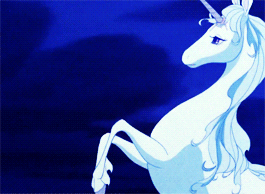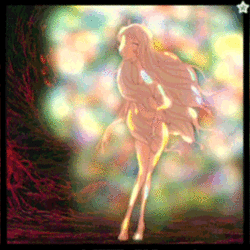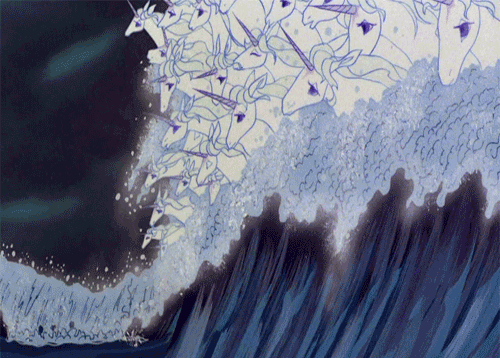1982's The Last Unicorn is a Dark, Surreal and Kid-Unfriendly Kid's Film with a Fine Voice Performance by Alan Arkin
Welcome, friends, to the latest entry in Control Nathan Rabin 4.0. It’s the career and site-sustaining column that gives YOU, the kindly, Christ-like, unbelievably sexy Nathan Rabin’s Happy Place patron, an opportunity to choose a movie that I must watch, and then write about, in exchange for a one-time, one hundred dollar pledge to the site’s Patreon account. The price goes down to seventy-five dollars for all subsequent choices.
Over the course of this project I have noticed certain themes in the movies you choose for me to watch and write about. Nightmare-inducing children’s films from the 1980s are disproportionately represented in this column, for example.
The late, lamented David Bowie and his distracting codpiece took center stage in Control Nathan Rabin 4.0 entry Labyrinth but I’ve also written about Jim Henson’s other child-traumatizing fantasy epic of the era, The Dark Crystal, the wonderfully bonkers 1980s animated rock musical Rock & Rule, Disney’s famously grim mid-1980s commercial nadir The Black Cauldron and the infamously perverse and bleak Canadian fantasy The Peanut Butter Solution.
Despite its Lisa Frank-friendly title, I am happy to report that Rankin-Bass’ 1982 fantasy film The Last Unicorn belongs in this patron-funded pantheon of wonderfully disturbing family films that are ultimately way too disturbing and dark to be appropriate for children.
The Last Unicorn begins with the title character living in an enchanted forest, a Garden of Eden where she lives in a state of perfect harmony with nature. It’s an unspoiled paradise except for the agonizing loneliness that comes with ostensibly being the last of your breed, tragically alone, isolated from the rest of the world.
Mia Farrow lends the perfect air of beatific innocence and otherworldly gentleness to the title role. It’s typecasting at its finest; Farrow has such an ethereal presence that it’s easier to buy her as a mythical creature renowned for its beauty and purity than it is as an ordinary human being.
Then one day a manic butterfly voiced by Robert Klein that sings World War II-era songs and spits out dialogue like, “You’re my everything, you are my sunshine, you are old and gray and full of sleep, you’re my pickle-face, consumptive Mary Jane” informs her that an evil creature known as the Red Bull has driven every other unicorn in the world into the sea.
The unicorn sets out on a Joseph Campbell’s hero’s journey to find and liberate the rest of the world’s unicorn population. The Last Unicorn is full of heady, cerebral ideas. Reality and perception, for example, are both intensely subjective here. People do not see what is before them so much as they see what they want to see, and are able to see, or are brainwashed and deceived into seeing.
When the unicorn ventures into the outside world human beings cannot see her true self. Instead of a unicorn, people only see a white mare. It takes special powers of perception to see the unicorn’s true self, an ability the malevolent, crone-like Mommy Fortuna, an evil witch voiced by Angela Lansbury, unfortunately possesses.
In The Last Unicorn there is also a sentient tree with enormous breasts, which, truth be told, is a little disturbing
The witch can see what others cannot; she also possesses the supernatural ability to make others see things that are not there. She uses and abuses this power to run an even sadder than usual traveling carnival of wonders.
Fortuna’s black magic allows simple-minded souls to look at an emaciated lion and see a fantastical manticore. Fortuna instantly intuits the unicorn’s true nature but because human beings can’t see her horn the grubby, desperate circus of greed and exploitation sticks a tacky fake horn on her head to complement the real one.
This boldly grim, even nightmare-inducing interlude allows the film to indulge in that great, dependable child traumatizer beloved by makers of unnecessarily grim kiddie fare: beautiful animals being viciously abused by sociopaths. That provided some of the most haunting moments in the perversely fucked-up Sesame Street spin-off Follow That Bird and it establishes an appropriately bracing tone of grimness mixed with whimsy and extraordinary beauty and lyricism.
Our heroine eventually escapes Mommy Fortuna’s circus of horrors with the help of Schmendrick, a bumbling magician voiced by Alan Arkin whose greatest dream in life is to perform real magic, to be a bona fide wizard and not just a hack deceiving rubes with card tricks and sleight of hand.
Halfway through The Last Unicorn something decidedly unexpected happens. In order to move through the world undetected, Schmendrick transforms our hero from a unicorn into a beautiful human woman.
Within the body and soul of this immortal unicorn lie a smoking hot human babe all along, a big-eyed waif who looks a little like Sailor Moon. The unicorn’s transformation into a beautiful, mortal human woman raises all manner of complicated and troubling questions the movie does not have much interest in answering.
In her human form as mysterious beauty Lady Amalthea, the unicorn attracts the attention and adoration of Prince Lí (Jeff Bridges, one of many huge, perfectly cast names in one of the most remarkable voice casts ever assembled), the heroic adopted son of King Haggard (Christopher Lee), the keeper of the Red Bull.
When he sets eyes upon this bewitching woman, Prince Lair does what heroes and princes inevitably do in stories like this when confronted with great beauty; he falls instantly in love and sets about wooing her through acts of great bravery and heroism.
Not even the revelation that the woman he is desperately in love with was a unicorn until fairly recently can cool the Prince’s ardor. When Schmendrick points out, as diplomatically as possible, that Lady Amalthea is unlike other women, in that she’s actually a unicorn, Prince Lair replies by very firmly insisting, “I love whom I love.”
Before there was Sharknado there was Unicornado!
As voiced by Lee, King Haggard is a figure of overwhelming, overpowering misery, a royal whose defining characteristic is his all too relatable inability to be happy.
The only thing that has ever made this monarch of constant sorrow happy are unicorns, so he had the demonic Red Bull herd all of the unicorns in the world except one into the sea, where they exist in a state of imprisonment, servitude and enslavement, tossed and torn by the waves and separated violently from the rest of the world.
It’s a goddamn watery unicorn apocalypse, is what it is, a water-logged mythical concentration camp. King Haggard is a monster, and a villain, but there’s something achingly relatable about his desperate desire to be happy, to experience peace, contentment and joy, and his utter inability to experience anything other than pain and torment unless he is actively abusing and imprisoning some of the most beautiful, spiritual and pure creatures in the world.
To be human is to feel pain, to experience the bittersweet horror of mortality and aging and death. Then again, you don’t need to be human in order to suffer in the grim hellscape of The Last Unicorn. To writhe in pain and discomfort due to the cruelty of an insane and sadistic world is the lot of all of its characters, not just the cursed unicorn at its center.
The Last Unicorn is a film of great beauty and tremendous sadness, a lyrical exploration of loneliness, regret, love and a need to find connection and meaning that unites all of God’s creatures, not just those with a single magical horn. Also, I suppose, it’s about a dude who wants to get it on with a sometimes unicorn he’s in love with, but I prefer not to think about that aspect too much.
Though it was directed and produced by Arthur Rankin and Jules Bass of Rankin-Bass, the stop-motion animation specialist behind Christmas classics like Rudolph the Red-Nosed Reindeer and Santa Claus is Coming to Town, the actual animation was handled by a Japanese company called Topcraft that would later form the core of Studio Ghibli, the studio behind Hayao Miyazaki’s masterpieces.
The Last Unicorn shares with Miyazaki’s work a genuine sense of wonder and awe as well as a sense that the world is infinitely more mysterious and magical and scary than it seems.
I went into The Last Unicorn blind and came away thoroughly impressed and moved. Fucked up kids movies from the 1980s is rapidly becoming one of my favorite cinematic sub-genres. So if you’ve got more kiddie-traumatizers from the Reagan decade for me to see and write about, send them my way and we can work through your nostalgia nightmares together in a cathartic and productive, not to mention low-key lucrative fashion.
Check out The Joy of Trash: Flaming Garbage Fire Extended Edition at https://www.nathanrabin.com/shop and get a free, signed "Weird Al” Yankovic-themed coloring book for free! Just 18.75, shipping and taxes included! Or, for just 25 dollars, you can get a hardcover “Joy of Positivity 2: The New Batch” edition signed (by Felipe and myself) and numbered (to 50) copy with a hand-written recommendation from me within its pages. It’s truly a one-of-a-kind collectible!
I’ve also written multiple versions of my many books about “Weird Al” Yankovic that you can buy here: https://www.nathanrabin.com/shop
Or you can buy The Joy of Trash from Amazon at https://www.amazon.com/Joy-Trash-Nathan-Definitive-Everything/dp/B09NR9NTB4/ref=tmm_pap_swatch_0?_encoding=UTF8&qid=&sr= but why would you want to do that?
Check out my new Substack at https://nathanrabin.substack.com/
And we would love it if you would pledge to the site’s Patreon as well. https://www.patreon.com/nathanrabinshappyplace









